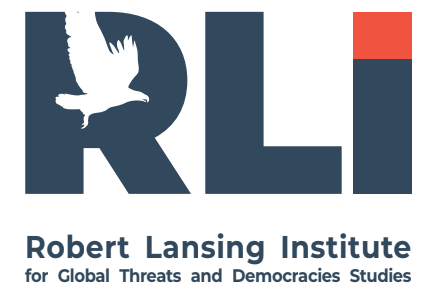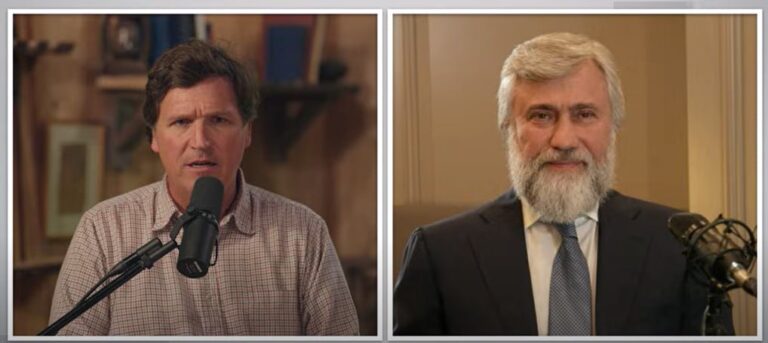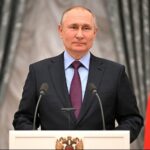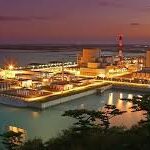Tucker Carlson’s interview with Vadim Novinsky represents a calculated piece of Russian information warfare, designed to serve Kremlin interests at a time of heightened geopolitical tension. Novinsky, an oligarch-turned-churchman with dual Ukrainian-Russian identity, is positioned as a “spiritual” authority to launder political messaging through religious language. The choice of Novinsky—and the platform of a Western influencer like Carlson—signals a strategic attempt to normalize Russian narratives in the West, obscure war crimes under a veil of Orthodox Christianity, and use the Church as a tool of intelligence and influence operations abroad.
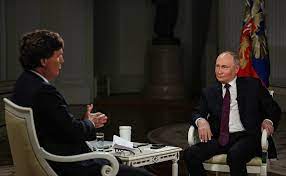
More on this story: malign propaganda in the West speculates on church issues
1. Why Now? The Strategic Timing
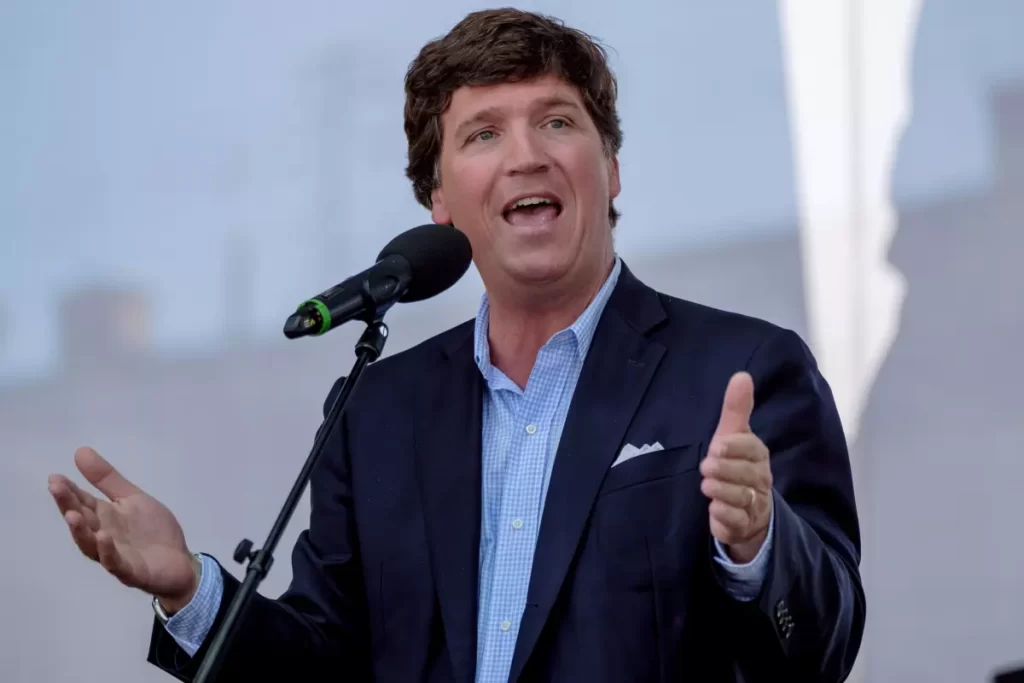
More on this story: Russia still on with effort to meddle in U.S. elections
- Narrative Reframing Ahead of U.S. Elections: The interview appears amid rising debates in the U.S. about support for Ukraine. By promoting a “spiritual” voice sympathetic to Moscow, Russia aims to influence isolationist or Christian-conservative circles in the West.
- Backlash Against the Orthodox Church in Ukraine: The Ukrainian government recently intensified pressure on the Moscow-linked Ukrainian Orthodox Church (UOC-MP), banning it from state institutions. Moscow wants to cast this as “religious persecution” to divide Western Christian opinion.
- Diversion from War Crimes and Occupation: The Kremlin benefits from redirecting attention away from atrocities in Ukraine toward moralistic narratives of religious victimhood and Russophobia.
2. Why Vadim Novinsky? His Function and Symbolism
- Dual Identity: Novinsky, a Ukrainian-Russian billionaire and UOC-MP deacon, claims a spiritual, apolitical role—yet he has deep business and political ties to the Kremlin.
- Asset of Influence: Sanctioned by Ukraine for aiding Russian occupation authorities, Novinsky is useful to Moscow as a “non-official” channel. His religious role allows him to operate under the radar while still spreading pro-Kremlin narratives.
- Martyrdom Framing: Carlson’s choice of Novinsky allows Russia to present a persecuted, pious image to conservative Western audiences, particularly targeting U.S. evangelicals and Orthodox sympathizers.
Vadim Novinsky is most likely connected—indirectly but consistently—to Russia’s FSB (Federal Security Service) through his ties to the Russian Orthodox Church (ROC) and Kremlin-affiliated business and influence networks.
FSB: Russia’s Primary Handler of Religious and Domestic Influence Operations
1. FSB as the Overseer of the Russian Orthodox Church
- The Russian Orthodox Church, particularly under Patriarch Kirill, is known to be under the supervision of the FSB, formerly the KGB. Kirill himself is widely reported to have operated under the KGB codename “Mikhailov.”
- The FSB’s Department for Defense of Constitutional Order and Fight Against Terrorism (also known as the “religious affairs department”) has long been involved in controlling or manipulating religious organizations for political purposes.
Novinsky, as a deacon of the Ukrainian Orthodox Church–Moscow Patriarchate (UOC-MP) and a close ally of Russian religious and political elites, falls squarely within that zone of control.
2. UOC-MP as a Tool of Russian Influence in Ukraine
- The UOC-MP has been repeatedly accused by Ukrainian officials and intelligence agencies of serving as a proxy for Russian soft power and espionage. Dozens of its clergy have been investigated or expelled for collaboration since 2022.
- Novinsky, a billionaire and longtime UOC-MP backer, helped fund and promote this network in Ukraine under the guise of religious and humanitarian work—a classic FSB-style cover for political and intelligence operations.
This suggests at minimum coordination or compliance with the FSB’s strategic goals, if not direct tasking.
3. FSB Handles Counterintelligence, Soft Power, and Internal Subversion
Compared to the other agencies:
| Agency | Likelihood of Link to Novinsky | Role |
| FSB | High | Oversees domestic intelligence, church affairs, ethnic/religious policy, ideological ops |
| SVR | Possible (low) | Foreign intelligence agency; more focused on embassies and deep-cover agents abroad |
| GRU | Unlikely | Military intelligence; focused on battlefield operations, sabotage, assassinations—not clergy or soft power networks |
The FSB fits Novinsky’s profile best, as his main function has been influence operations within Ukraine and among Russian-speaking Orthodox communities—not foreign espionage or military sabotage.
4. Business-Religious Networks Tied to FSB-Controlled Oligarchs
- Novinsky’s business empire and religious activity intersect with those of Konstantin Malofeev, who has known links to the GRU (mil intel) and funds Orthodox nationalist causes across Europe.
- Malofeev is believed to coordinate with the FSB in recruiting or directing Orthodox activists in Serbia, Montenegro, France, and Bulgaria—an ecosystem in which Novinsky fits perfectly.
5. Carlson Interview as FSB-Directed Narrative Channel
The recent Tucker Carlson interview with Novinsky is likely part of an FSB narrative operation aimed at:
- Whitewashing Russia’s role in Ukraine through “spiritual concern” narratives,
- Infiltrating Western Christian discourse,
- And legitimizing Kremlin-aligned religious actors abroad.
This type of media engagement—non-kinetic, ideological, and deniable—is a textbook FSB approach.
Conclusion: FSB is the Closest Agency to Novinsky
- Functionally, Novinsky aligns with FSB interests: domestic destabilization of Ukraine, manipulation of religion for political goals, and ideological warfare.
- Institutionally, his proximity to the Russian Orthodox Church and oligarchic circles aligned with the Kremlin places him under FSB oversight, whether through surveillance, coordination, or tasking.
Vadim Novinsky and Konstantin Malofeev share notable similarities that place them within the same ecosystem of Kremlin-aligned oligarchs using Orthodox Christian narratives, financial influence, and geopolitical ambitions to further Russian state objectives, both domestically and abroad. Here’s a comparative analysis:
Novinskyand Malofeev: Parallels in Power, Faith, and Propaganda
1. Oligarchs with Ideological Missions
| Aspect | Vadim Novinsky | Konstantin Malofeev |
| Origin | Ukrainian-born Russian businessman with major interests in metallurgy and oil | Russian financier with investments in media, tech, and Orthodox charity |
| Political Role | Former MP in Ukraine (Party of Regions); sanctioned for supporting Russian war effort | Key funder of pro-Russian separatists in Donbas; associated with Russian ultranationalist circles |
| Religious Affiliation | Deacon in the Ukrainian Orthodox Church–Moscow Patriarchate (UOC-MP) | Devout Orthodox monarchist; close to Russian Orthodox Church and Tsarist restoration groups |
| Narrative Usage | Portrays Russia as spiritual savior of persecuted Orthodoxy in Ukraine | Frames Russia as the last bastion of Christian civilization against globalism |
Both men blur the line between faith and political subversion, using Orthodox identity as a Trojan horse for imperialist messaging.
2. Influence Operations and Soft Power
- Novinsky: Focuses on Ukraine, leveraging his UOC-MP ties to sow discord, undermine Zelensky, and present Ukraine’s rejection of the Moscow Patriarchate as religious repression. His recent media appearances (e.g., Carlson interview) reflect external narrative engineering targeting Western Christian conservatives.
- Malofeev: Operates more globally, financing Orthodox-aligned and far-right networks in Europe, Serbia, France, and the Balkans. Linked to ideological think tanks (e.g., Katehon), whitewashing Russian revanchism as Christian revival.
🔍 Overlap: Both are suspected to operate as cut-outs for Russian intelligence—fronts through which ideology, money, and disinformation flow.
3. Religious Infrastructure as Geopolitical Tool
- Churches as Strategic Assets: Both use churches, foundations, and religious NGOs as vehicles for influence operations, often shielded from scrutiny due to their spiritual veneer.
- Patriarch Kirill as Central Node: Their ties to the ROC leadership (especially Kirill) reinforce the Church’s strategic alignment with the Kremlin, making religious networks a de facto extension of Russian foreign policy.
4. Instrumentalization of Western Audiences
- Malofeev funds and courts European far-right politicians and Catholic conservatives (e.g., France’s Le Pen, Italy’s Salvini), positioning Russia as Europe’s moral compass.
- Novinsky, especially post-2022, is tailored more toward American religious conservatives, using figures like Tucker Carlson to create a parallel pro-Russian narrative inside U.S. discourse.
Both target disillusioned, culturally conservative, and anti-globalist segments of society, exploiting religious identity as a vector for political loyalty to Moscow.
5. Legal and Sanctions Status
- Novinsky: Sanctioned by Ukraine for collaboration; avoided Russian constitutional roles to maintain his ambiguous identity and foreign access.
- Malofeev: Sanctioned by the U.S. and EU since 2014 for financing separatists in Donbas; a known sponsor of mercenaries and ideological networks.
Their operations continue under quasi-legal fronts, often exploiting religious freedom laws and charitable status in Western jurisdictions.
Two Faces of the Same Doctrine
Novinsky and Malofeev represent two pillars of a single Russian strategy: the weaponization of Orthodoxy and ultranationalist oligarchy to support the Kremlin’s war aims, both militarily and in the information domain.
- Novinsky is more embedded in Ukrainian affairs and useful in deflecting attention from Russia’s occupation by invoking religious persecution.
- Malofeev is the more openly ideological architect, building an international Orthodox-nationalist ecosystem.
Together, they illustrate how Russia merges spiritual language, oligarchic finance, and covert influence into a sophisticated hybrid warfare strategy.
Would you like a chart or annex outlining their influence networks or media channels?
3. The Russian Orthodox Church’s Role in the War
- Ideological Justification: Patriarch Kirill and ROC hierarchy openly bless the war as a “holy” struggle against Western liberalism and “Satanic” values. This sanctifies the invasion and rallies domestic support.
- Soft Power and Obedience: The Church is not independent. It serves as an extension of state power, promoting the Kremlin’s worldview and suppressing dissent within Russia and occupied territories.
- Church as Cultural Occupier: In annexed areas, Moscow quickly installs ROC clergy to replace local religious leadership, legitimizing Russian control.
4. The Church as an Intelligence Asset
- Cover for Operations: ROC institutions abroad often serve as platforms for Russian intelligence operatives. Churches and monasteries provide safe houses, meeting points, and surveillance hubs under religious immunity.
- Recruitment and Propaganda: In Europe and the Balkans, ROC parishes have been linked to efforts to recruit pro-Russian activists, spread disinformation, and funnel Kremlin funds to sympathetic groups.
- Diaspora Manipulation: The ROC influences Russian-speaking diaspora communities in the West, often steering them toward narratives hostile to NATO, Ukraine, and liberal democracy.
5. Tucker Carlson’s Role in the Kremlin’s Playbook
- Amplifier of Disinformation: Carlson has become a vector of Kremlin-aligned content, often criticizing U.S. foreign policy and echoing Russian talking points on Ukraine.
- Targeting U.S. Conservatives: By framing Russia as a Christian bulwark against Western decadence, Carlson provides ideological comfort to parts of the U.S. right wing who may be disillusioned with continued support for Ukraine.
- Creating Moral Ambiguity: Presenting Novinsky as a misunderstood man of faith seeks to muddy Western perception of the conflict, casting doubt on the moral clarity of Ukraine’s defense.
Tucker Carlson’s interview with Vadim Novinsky is a deliberate Kremlin information operation, aimed at sowing division in the West, sanctifying Russian aggression, and shielding its crimes under religious rhetoric. The Russian Orthodox Church is not a passive institution, but an active participant in the state’s geopolitical agenda. Western policymakers must treat religious diplomacy from Moscow with the same strategic scrutiny as energy or military operations.
Vadim Novinsky’s potential public thanks or deference to a U.S. vice president—whether symbolic or strategic—would likely be part of a calculated information operation or a gesture aimed at legitimizing his role as a “spiritual” figureand softening his image in Western circles.
Why Would Novinsky Thank a U.S. Vice President?
1. To Signal Openness to Dialogue—and Undermine Ukraine
If Novinsky were to publicly thank the U.S. vice president meant to:
- Portray himself as a moderate “bridge figure”: A peacemaker between East and West, especially valuable to Russian propaganda during times of heightened U.S.-Russia hostility.
- Contrast himself with Ukraine’s leadership: By positioning himself as “grateful” and open to the West, Novinsky undermines the image of Ukraine as unified and justified in its rejection of the UOC-MP.
- Create confusion about loyalty: As someone sanctioned by Ukraine but deferential to U.S. leaders, Novinsky tries to blur the lines between subversive actor and legitimate interlocutor.
2. To Support Russia’s “Religious Freedom” Disinformation Campaign
A statement of thanks could be framed as gratitude for Western concern over “religious persecution” of Orthodox Christians in Ukraine—a Kremlin disinformation narrative. By thanking a U.S. leader:
- Novinsky taps into the American evangelical or Catholic conservative base, some of whom have sympathized with this narrative.
- It gives false legitimacy to the Russian Orthodox Church’s role as a victim, rather than a Kremlin instrument.
This tactic echoes what ROC officials and Kremlin-linked NGOs have done in UN forums, U.S. conferences, and European parliaments—using Western freedom-of-religion rhetoric to defend their political agenda.
3. To Shield Himself from Sanctions or Legal Action
- A message of gratitude could be part of a broader lobbying or reputational laundering campaign aimed at blocking or reversing sanctions, especially in jurisdictions like the EU or U.S.
- By showing appreciation toward a Western political figure, he can frame himself as a moderate, apolitical religious leader, rather than a Kremlin tool.
This is a common strategy for sanctioned oligarchs—performing public diplomacy through religious or humanitarian gestures to evade scrutiny and regain access to Western platforms.
4. To Prepare for Post-War Negotiations
Novinsky may see himself as a potential religious or cultural mediator in any future postwar settlement. Public gestures toward U.S. leadership could be part of:
- A self-positioning campaign to insert himself as a relevant actor.
- A way to rebrand himself in the West as someone who “never supported violence” but was simply caught between two nations.
Such figures have historically been used by Russia in frozen conflicts (e.g., Transnistria, South Ossetia) to push narratives of “peace,” “neutrality,” and “common Christian values.”
If Vadim Novinsky publicly thanks a U.S. vice president, it should be interpreted not as a sincere diplomatic gesture but as a tactical move within a broader influence campaign. It is designed to:
- Legitimize the Kremlin’s religious messaging,
- Divide Western opinion on Ukraine,
- Protect Novinsky from sanctions,
- And possibly pave the way for his involvement in future diplomatic efforts.
Vadim Novinsky’s propaganda is dangerous for both the United States and Donald Trump because it blends religious manipulation, pro-Russian disinformation, and strategic soft power influence in a way that:
- Undermines U.S. national unity and trust in institutions,
- Weakens Western support for Ukraine, and
- Creates a false affinity between Russian authoritarian ideology and U.S. conservatism, damaging the credibility of the American right—especially Trump’s political base.
Here’s a detailed breakdown of why Novinsky’s narrative operations are so perilous:
🧠 I. Why Novinsky’s Propaganda Threatens the U.S.
1. 🇷🇺 It Pushes Kremlin Narratives Through a Religious Lens
- Novinsky uses his role in the Ukrainian Orthodox Church–Moscow Patriarchate and his Western media appearances (e.g., with Tucker Carlson) to frame the war in Ukraine as a “spiritual conflict”.
- This promotes the idea that Russia is defending Christian civilization, while portraying Ukraine and its allies (the U.S. and EU) as anti-Christian or godless.
🧨 Impact: This falsely aligns Russia’s geopolitical aggression with conservative Christian values, confusing and radicalizing segments of the U.S. public—especially in right-wing or evangelical circles.
2. 🧩 It Amplifies Divisive Culture War Tropes in the U.S.
- Novinsky’s messaging often mirrors Kremlin propaganda: anti-LGBTQ, anti-globalist, anti-NATO, anti-“woke” ideology.
- These talking points are amplified in U.S. conservative media, giving Russia a backdoor to shape American public discourse without overt government fingerprints.
🧨 Impact: This deepens internal U.S. divisions, weakens democratic cohesion, and serves Russian interests by encouraging Americans to see domestic opponents as enemies, rather than focusing on Russia as a real threat.
3. 💻 It Legitimizes Russian Influence Operations via “Religious Diplomacy”
- Novinsky’s appearances in U.S.-based media can whitewash the image of Russian intelligence-linked Orthodox actors as merely “concerned spiritual figures.”
- This opens doors for further intelligence penetration, money laundering, and subversion through religious NGOs, church exchanges, and think tanks.
🧨 Impact: The U.S. may lower its guard against Orthodox Church-linked actors, allowing FSB-affiliated proxies to operate more freely in U.S. institutions.
I It’s Dangerous Specifically for Donald Trump
1. It Makes Trump Look Like a Kremlin-Aligned Stooge
- By aligning with Carlson and narratives that sympathize with Novinsky or the ROC, Trump’s movement risks being seen as indistinguishable from pro-Putin ideologues.
- Novinsky’s messaging falsely presents Putin and Trump as ideological allies—which might appeal to Trump’s base but is politically toxic in the general electorate.
Impact: This endangers Trump’s political credibility and undermines his claim to be a patriotic, America-first leader. He may be seen instead as a conduit for hostile foreign narratives.
2. It Contradicts Trump’s Claim to End the War Quickly
- Novinsky’s propaganda justifies continued Russian aggression as a holy mission, contradicting Trump’s frequent claim that he could end the war “in 24 hours.”
- If Novinsky’s voice becomes louder in the American conversation, it exposes the falseness of any idea that Russia is ready for peace.
Impact: This damages Trump’s negotiator image, especially among independents or foreign policy conservatives who might otherwise support his “deal-maker” persona.
3. It Could Trigger National Security Backlash
- If Trump allies himself too closely with voices like Novinsky or platforms them through surrogates (e.g., Carlson), it opens him up to national security criticism.
- The intelligence community may raise red flags that Trump’s campaign is being used—again—to amplify Russian disinformation or legitimize Kremlin proxies.
Impact: This risks reigniting scandals similar to 2016, weakening Trump’s electoral prospects and placing his team under FBI, FISA, or Congressional scrutiny.
Vadim Novinsky’s propaganda is a Trojan horse:
- Cloaked in religious authority and spiritual concern,
- Designed to destabilize Western democracies, and
- Exploiting internal rifts in the U.S. political right to weaken American resolve.
For the United States, it’s a threat to social cohesion and strategic clarity.
For Donald Trump, it’s a political liability disguised as ideological support—and one the Kremlin would happily exploit.
Countering the Propaganda of Vadim Novinsky and Kremlin-Affiliated Religious Actors
1. Raise Strategic Awareness of Religious Influence Operations
Target Audience: U.S. Intelligence Community, National Security Council, Congressional Committees
- Classify Russian Orthodox Church (ROC) political actors—such as Novinsky—as part of Russia’s non-kinetic warfare apparatus.
- Issue internal threat assessments to identify ROC figures with ties to the Kremlin, FSB, or sanctioned oligarchs like Malofeev.
- Publicly warn that ROC-affiliated actors may be used to conduct influence operations and narrative warfare on U.S. soil and in allied countries.
2. Defend Religious Institutions from Foreign Subversion
Target Audience: Department of Justice (DOJ), FBI, IRS, Homeland Security
- Investigate church-linked NGOs, media platforms, or nonprofits that may act as unregistered foreign agents or laundering mechanisms for Kremlin-linked donors.
- Strengthen transparency laws requiring churches and faith-based organizations with foreign funding to disclose such ties.
- Encourage domestic churches to adopt internal protocols to prevent ideological infiltration or funding from authoritarian regimes.
3. Brief Political Campaigns on Influence Risks
Target Audience: Political campaign leadership, especially on the right
- Provide closed-door briefings to major U.S. campaigns (including Trump’s) on the risks of platforming Kremlin-aligned religious actors, such as Novinsky or proxies.
- Encourage campaign staff and media surrogates (e.g., influencers, journalists) to vet guests and talking points for foreign influence alignment.
- Clarify that promoting Kremlin-originated “Christianity vs. the West” narratives weakens the U.S. position and could trigger intelligence investigations or public backlash.
4. Empower Moderate Religious Voices
Target Audience: U.S. religious leaders, ecumenical councils, public theologians
- Promote independent Eastern Orthodox leaders who denounce ROC subservience to Putin and support peace, pluralism, and rule of law.
- Fund or amplify counter-narratives from Ukrainian Orthodox clergy who have severed ties with Moscow and denounce the war.
- Launch public awareness campaigns exposing how Putin weaponizes faith to justify aggression and manipulate Christian audiences globally.
5. Coordinate with Allies on ROC Political Activity
Target Audience: U.S. State Department, EU/NATO partners
- Include Kremlin-linked religious propaganda in hybrid threat assessments at NATO and EU forums.
- Support sanctions and visa bans on actors like Vadim Novinsky, Konstantin Malofeev, and ROC officials who enable war, disinformation, or espionage.
- Help Eastern European and Balkan states protect their Orthodox churches from Russian interference, especially where ROC branches are politically active.
Novinsky’s propaganda is not merely fringe religious speech—it is a strategically packaged, state-aligned ideological threat.
The U.S. should treat it as a subversive element of Russia’s hybrid warfare, and mobilize both national security toolsand religious community resilience to counter it.
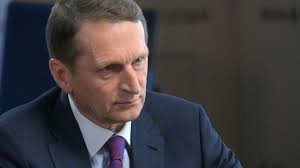
More on this story: Russian Monarch’s Family to address intelligence needs
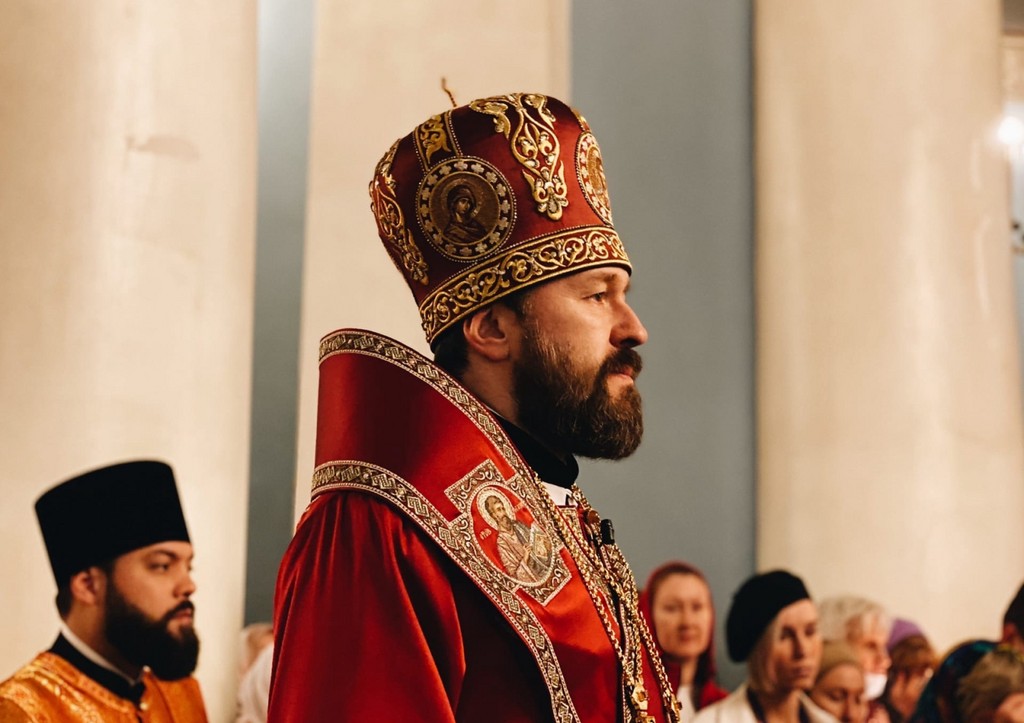
More on this story: Church: lobbying channels for Russia
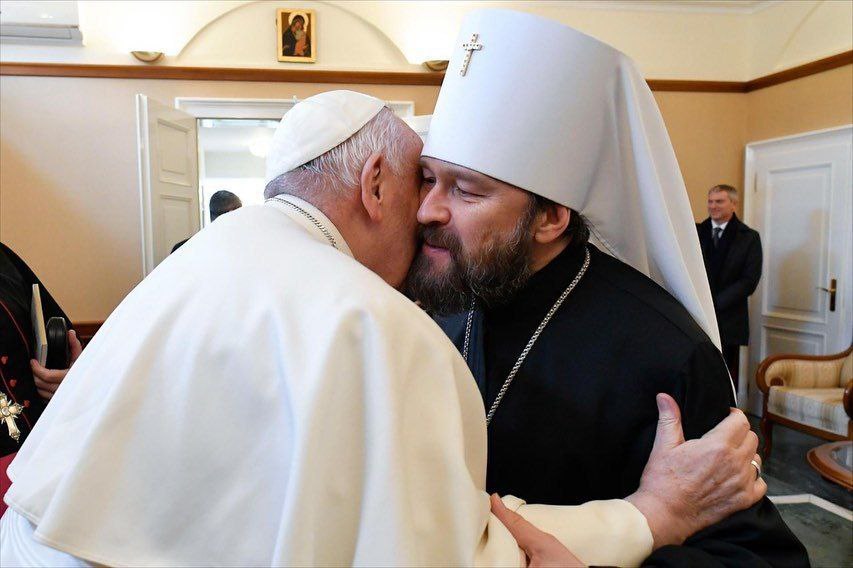
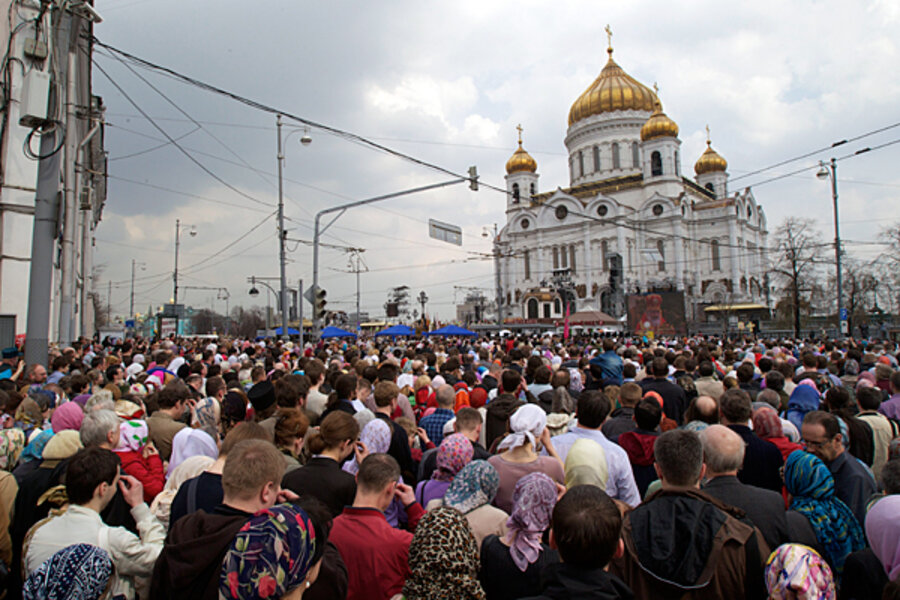
More on this story: Modern Russia. Role of the Orthodox Church in the State
